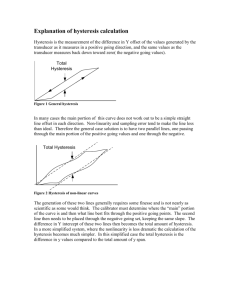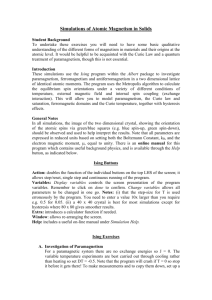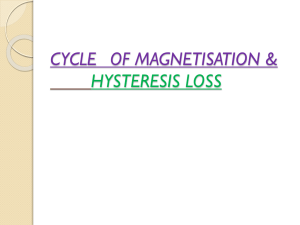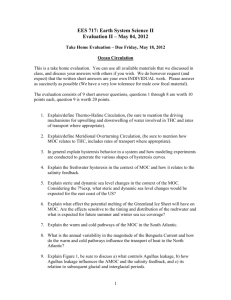1 - CERN
advertisement
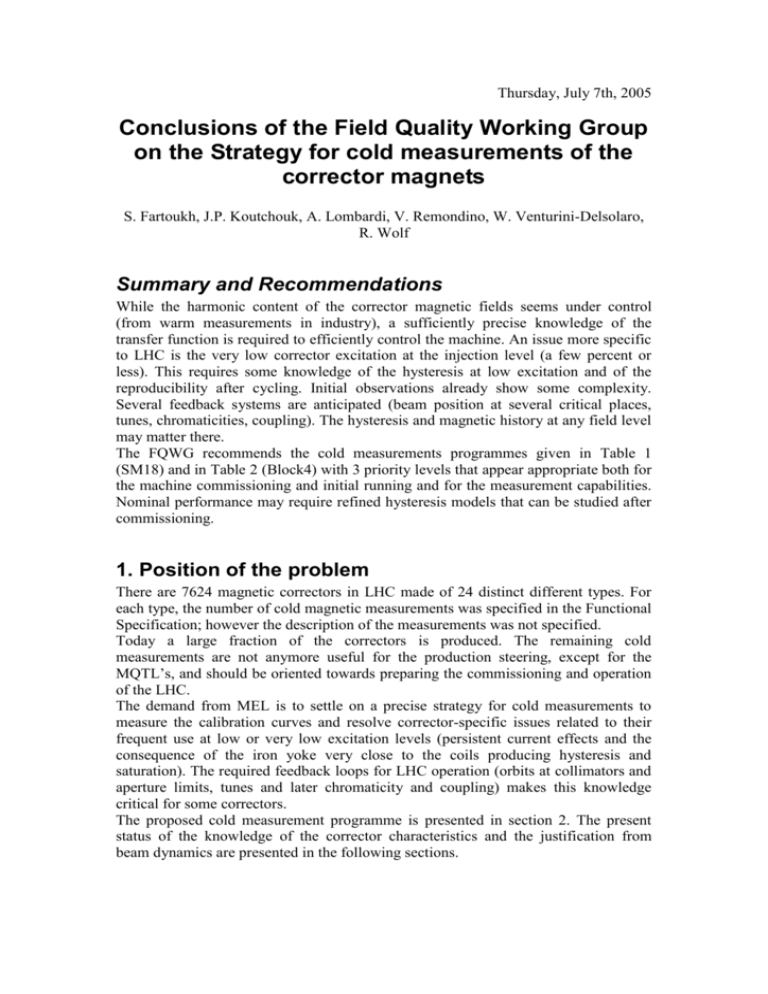
Thursday, July 7th, 2005
Conclusions of the Field Quality Working Group
on the Strategy for cold measurements of the
corrector magnets
S. Fartoukh, J.P. Koutchouk, A. Lombardi, V. Remondino, W. Venturini-Delsolaro,
R. Wolf
Summary and Recommendations
While the harmonic content of the corrector magnetic fields seems under control
(from warm measurements in industry), a sufficiently precise knowledge of the
transfer function is required to efficiently control the machine. An issue more specific
to LHC is the very low corrector excitation at the injection level (a few percent or
less). This requires some knowledge of the hysteresis at low excitation and of the
reproducibility after cycling. Initial observations already show some complexity.
Several feedback systems are anticipated (beam position at several critical places,
tunes, chromaticities, coupling). The hysteresis and magnetic history at any field level
may matter there.
The FQWG recommends the cold measurements programmes given in Table 1
(SM18) and in Table 2 (Block4) with 3 priority levels that appear appropriate both for
the machine commissioning and initial running and for the measurement capabilities.
Nominal performance may require refined hysteresis models that can be studied after
commissioning.
1. Position of the problem
There are 7624 magnetic correctors in LHC made of 24 distinct different types. For
each type, the number of cold magnetic measurements was specified in the Functional
Specification; however the description of the measurements was not specified.
Today a large fraction of the correctors is produced. The remaining cold
measurements are not anymore useful for the production steering, except for the
MQTL’s, and should be oriented towards preparing the commissioning and operation
of the LHC.
The demand from MEL is to settle on a precise strategy for cold measurements to
measure the calibration curves and resolve corrector-specific issues related to their
frequent use at low or very low excitation levels (persistent current effects and the
consequence of the iron yoke very close to the coils producing hysteresis and
saturation). The required feedback loops for LHC operation (orbits at collimators and
aperture limits, tunes and later chromaticity and coupling) makes this knowledge
critical for some correctors.
The proposed cold measurement programme is presented in section 2. The present
status of the knowledge of the corrector characteristics and the justification from
beam dynamics are presented in the following sections.
2. Proposed Cold Measurement Programme
2.1. Goals and priorities
1. Construct calibration curves for all correction circuits. The number of
magnets and of points on the load lines should be such that the required
accuracy (see section 3) is achieved at any point of the calibration curve.
2. Establish the warm-to-cold correlation to allow a full use of the wealth of
warm measurements available (both transfer function and harmonics).
3. Characterize the hysteresis and its reproducibility with priority for the
magnets in feedback loops: All types of orbit correctors [1], MQT, (MS,
MQS).
4. Investigate degaussing cycles to reduce the remnant fields at the level
required for machine reproducibility.
5. Measure the MQTL’s to be used as Q6 in IR3 and IR7.
6. Investigate the possible crosstalk between channels (e.g. MQTL at high
field) and between layers for multi-layer correctors.
2.2. Measurements in SM18
In order to minimize the number of detailed cold measurements discussed in the
former section, it is important to establish the size of the smallest significant
sample. For that purpose, systematic simplified measurements should be carried
out in SM18 to i) to identify the spread, mostly for the transfer function, ii) to
ascertain that a warm-to-cold correlation holds. This should be carried out for all
correctors whenever a cryomagnet is magnetically measured at cold.
The measurement cycle is defined to be:
{0,INJ,NOM/2,NOM,NOM/2,INJ,0,-INJ,-NOM/2,-NOM,-NOM/2,-INJ,0}
following a standard pre-cycle. INJ is defined for each corrector type in Table 1.
Given the very low excitation at injection and the saturation at nominal excitation,
the NOM/2 level will be useful to qualify the spread.
Table 1: Series measurements in SM18
Corrector
# of
INJ
Priority
magnets
[% of
(estimate) nominal
field]
SSS
MS
10
1
1
MS skew
3
6
1
MSCBH
10
6
1
MSCBV
10
6
1
MO
10
6
1
MQT
10
1
1
MQS
3
6
1
MB
MCS
50
6
1
MCD
25
25
1
MCO
25
6
1
5.3. Extended Measurements in Block 4
The programme which fulfils the goals presented in section 2.1 is given in Table 2 .
The number of magnets to be measured is an estimate that will be adjusted depending
on the SM18 series measurements. It already takes into account some optimization of
the efficiency of Block 4 measurements.
Table 2: Extended reference programme in Block 4
Corrector type
Measurement programme
description
MCS
Calibration curve B(I)
Accuracy of snap-back compensation
MCD
Calibration curve B(I)
Accuracy of snap-back compensation
Cross-talk with MCO
MCO
Calibration curve B(I)
Cross-talk with MCD
MS
Calibration curve B(I)
Reproducibility of INJ level after cycling
Hysteresis and effect of magnetic history
MO
Degaussing cycle
Calibration curve B(I)
MQT/MQS
Calibration curve B(I)
Hysteresis and effect of magnetic history
Reproducibility of INJ level after cycling
MCB, MCBC, Calibration curve B(I)
MCBY
Hysteresis and effect of magnetic history
Reproducibility of INJ level after cycling
MCBX
Calibration curve B(I)
Hysteresis and effect of magnetic history
Reproducibility of INJ level after cycling
Cross-talk between layers
MQTL
Calibration curve B(I)
Cross-talk between apertures at high field
Priority
# of magnets
12
3
6
3
3
6
(3)
6
6
6
4
4
4/1
6/2
6
6 of each
type
done
done
2
2
6
1
1
2
1
2
3
3
3
1
2
2
2
3
1
2
2
1
2
2
1
2
2
3
1
3
Definition of priorities:
1. required for commissioning
2. could improve significantly commissioning efficiency
3. can be done after commissioning on spare magnets
In addition, the expected absence of decay should be verified on the four types of
super-conducting cables.
3. Beam requirements for the correctors
3.1. Method for the definition of tolerances
To establish beam requirements for corrector magnets, correction strategies must have
been defined. There is generally a range of possibilities that cannot be explored at this
stage. The following requirements are based on the most straightforward correction
strategies which are simplest for machine operation. If some requirements cannot be
reasonably met, the correction strategy will be reconsidered.
Three tolerance parameters are defined:
Btrue Bdemanded (1 tol) resolution reproducib ility
The precision, expressed as a maximum relative error on the demanded
increment of field (tol), valid for any increment amplitudeBdemanded in a
range defined in column 2 of Table 3. This tolerance is loosened whenever a
correction can reasonably assume an iterative process combined with beam
measurements. The value acceptable for commissioning is estimated.
Operations will be more efficient (less iterations) if a better precision can be
reached.
The resolution of the correction system, taken as the tolerance on hysteresis
(columns 4 and 5 of Table 3).
The reproducibility after machine cycling which ideally should reach the
resolution on the long term and initially can be between 1 and 5 times the
resolution.
3.2. SSS correctors
The injection is the most critical phase for the use of the SSS correctors. The
requirements on the transfer function and hysteresis are given in Table 3 [2] [3].
These estimates are consistent with the beam requirements at commissioning and
assume a gain by an order of magnitude is possible by beam measurements on the
way to higher performance. If magnetic measurements can be more accurate than
specified, a gain in machine operations efficiency can be anticipated.
The alignment tolerance of the magnetic axis with respect to the reference orbit is
estimated to be about 0.2 mm rms.
The tolerances for the harmonics follow the “10% principle” and are given in the
FQWG minutes of the 4-3-2004 and 16-11-2004. They are not recalled here as they
do not appear critical and have thus no impact on the cold measurements at CERN.
Table 3: Beam requirements for SSS correctors
Corrector
Operational
range at
injection
[% of
nominal]
TF relative
accuracy for
commissioning
(tol)
MQT
MQS
MS
<5 %
5%
<5 %
MCB
0 0.5-1
06
1.1/1.9 for
MSF/MSD
06
Hysteresis at
injection [field
integral @ 17 mm]
[10-3 Tm]
relevant if larger
than …
(resolution)
0.032
0.128
0.074
<5 %
0.193
MO
0
10 %
0.096
Impact of the
hysteresis
at 450 GeV
Qx ~ Qy ~ 10-3
c- | ~ 0.5×10-3
Q’x/y ~ 1.2/0.7
x ~ y ~ 0.015 per
MCB, i.e. 0.2for
200 correctors
Q(6) = 5×10-4
3.3. MB correctors
The alignment tolerance of the magnetic axis with respect to the MB geometrical axis
is estimated to be around 0.4 mm rms. The tolerances for the harmonics are given in
[4] with an update in April 2005[5].
Table 4: Beam requirements for the MB correctors
Corrector
Operational
range at
injection
[% of
nominal]
TF relative
accuracy for
commissioning
MCS
MCO
MCD
1.5 9
08
16 33
<5 %
10 %
5%
Hysteresis at injection
[field integral @ 17
mm]
[10-3 Tm]
relevant if larger than
…
(resolution)
.011
.026
.092
Impact of the hysteresis at
450 GeV
Q’x ~ Q’y ~ 0.7
Q(6) = 5×10-4
Q(6, =10-3) = 5×10-4
3.4. SSSS correctors
Table 5: Beam requirements for the SSSS correctors
Corrector
Operational
range at
injection
[% of
nominal]
MCBC
06
MCBC
0.11 3.5
MCBY
06
MCBY
0.09 7.3
TF relative
Hysteresis at injection
accuracy for
[field integral @ 17
commissioning
mm]
[10-3 Tm]
relevant if larger than
…
(resolution)
<5 %
0.27
Impact of the hysteresis at 45
GeV
From Q10 to Q7 similar to
correctors in SSS
In Q6 to Q5 used for cross
scheme
In IR4 and IR6 used for
correction. x ~ y ~ 0.03 (
MCBY)
In IR1, IR2, IR5, IR8 (in Q5, Q
used for crossing scheme
3.5. Triplet correctors
The measured field quality of the triplet quadrupoles is such as to make the multipole
correctors unnecessary. Their field quality is thus uncritical [6]. The field quality of
the orbit correctors remains an important issue.
Table 3: beam requirements for triplet correctors
Corrector
TF relative
accuracy for
commissioning
MQSX
(a2)
MCSX
(b3)
~ 10 %
Operational range [% of Hysteresis at injection
nominal field]
and in collision[field
integral @ 17 mm]
450 GeV
7 TeV
[10-3 Tm]
(injection
(collision
relevant if larger than
optics)
optics)
(1)
(1)
1 6
20 100
≤ 0.45(3)
0 5(2)
0 70(2)
Impact of the hysteresis
at injection and in
collision.
c- | ~ 10-3 per IR(3)
c- | ~ 10-3 per IR(4)
≤0.86(4)
(equivalent to 10 % of the allowed
b3 in D1 in collision, i.e. 2 units)
MCTX
(b6)
MCSSX
(a3)
MCOX
(b4)
MCOSX
(a4)
0
0 50
0
0 60
0
0 100
(5)
1) At injection, integrated strength
~0.12
corresponding
~0.26/0.16
(5)
~0.07/0.34
(5)
to
the
specified
systematic b6/a3/b4/a4 in MQs (i.e.
2/4/1/1 units respectively)
2) In collision, integrated strength
equivalent to 10% of the one sigma
0
0 40
level of b6/a3/b4/a4 in one Q3
~0.07(5)
(that is 10 % of 0.4/ 0.6/ 1.5/ 0.3
units respectively)
: assuming roll angle errors of 0.2 mrad 1 mrad in MQX’s.
: taking into account the recent update of the MCSX nominal current from 50 to 90A.
(3)
: both at 450 GeV with injection optics (*=10 m) and 7 TeV with collision optics (*=0.5m)
(4)
: mainly for IR1 and IR2 with V-crossing (~200rad) both at 450 GeV with injection optics (*=10
m) and 7 TeV with collision optics (*=0.5m)
(5)
: Requested reproducibility (in particular hysteresis width) at injection/collision. These targets
contain a comfortable margin, especially at injection and may be reevaluated if needed.
(1)
(2)
4. Summary of the warm measurements[7]
Warm magnetic measurements are done on each magnet module in industry. The rms
spread of the magnetic parameters measured at 1 A is summarized in Table 6.
Corrector
module
#
modules
measured
Table 6: Summary of warm measurements
TF
B spread
Alignment
Tilt
Harmonics
spread
rms @
(H/V, mm
mrad
rms @
Imax
rms)
rms
Large values
Out of
1A
[10-3Tm]
tolerance
within module
MO
MS
289
441
0.27%
0.33%
0.26
1.55
0.037/0.033
0.048/0.049
1.015
1.895
MQT
MCB
MCS
MCD
MCO
88
397
2185
975
944
0.23%
0.33%
0.39%
0.48%
0.40%
1.54
6.15
0.055/0.054
1.715
c1, c2
c1: sys & rnd, b5: rnd×1.3
c9: sys
c2
.15±.1.2
.47±.91
.38±1.7
The field harmonics are measured in the same conditions and reported in [5]. It
should be noted that for MO’s and spool pieces, an ambiguity on the reference frame
was detected lately. Until it is resolved, the c-values ( a 2 b 2 ) should be
considered as a worst case for a’s or b’s.. Whenever beam dynamics tolerances are
specified for harmonics, their warm values are found in general within tolerance.
The last column of Table 6 gives those multipoles out of tolerance with their relative
value with respect to tolerance. It should be noted that tolerances are not specified
for some harmonics that appear high. In comparing measured warm harmonics to
cold tolerances, one assumes a high warm-cold correlation.
Beam dynamics studies are being done to assess the exact consequence of some
multipoles with large values.
It should be noted that the alignment and angles quoted in Table 6 are relative to the
module frame and thus are to be compared to the manufacturing tolerances and not
to the beam requirements.
5. Summary on the cold measurements [8]
5.1. Baseline Measurement Plan
The baseline specifies the number of magnet modules to be measured at cold. It does
not specify the types and conditions for the magnetic measurements. So far, cold
magnetic measurements have followed the following scenario: measurement at zero,
+nominal and – nominal excitation in SM18, while more extended measurements
have been done in Block4.
Table 7: Cold series measurements Plan (from magnet functional specs)
Corrector type
Planned
(assemblies, single or twin
apertures)
MCS
50
MCDO
50
MQT
10
MO
8
MSCB
10
Achieved
05/2005
0
0
4
8
6
MCBC
6
1
MQTL
3
0
MCBX + MCBXA
?
20
MQSX + MCSOX
9
9
Besides the spool pieces and the MQTL’s, the number of measurements is on good
tracks to satisfy the baseline demand.
5.2. Results of the cold measurement program
The detailed results are given in [6]. The uncertainty on the absolute calibration is of
the order of 1% (diff SM18/B4). The transfer function at nominal excitation seems to
be 3 to 5% off as compared to magnetic calculations. The transfer function spread and
hysteresis are summarized in
Table 8. The hysteresis quoted is the full width of the hysteresis curve expressed in
integrated field at zero excitation. The hysteresis effect is in general NOT negligible
with respect to beam optics requirements (in particular for the orbit corrector
MCBM, MCBC and MCBX). The full measurement of the transfer function carried
out on some magnets shows a significant saturation effect.
Table 8: Summary of cold measurements (FQWG, 4/5/2005)
Corrector # modules
TF spread Field spread # modules
Hysteresis
module
measured rms @ Imax rms @ Imax
measured
[10-3 Tm]
-3
[10 Tm]
MO
21
0.45%
0.44
4
0.23→ 0.46
MS
33
0.73%
3.4
1
1
MQT
8
0.55%
3.7
4
0.2
MCB
16
0.75%
14.0
4
1
MQTL
1
0.8
MCBC
1
1.3
MCBX
20
6
MCS
10
0.06
MCD
10
0.01
MCO
10
0.1
The harmonics are not analyzed yet in detail. There seems to be overall consistency
with the warm measurements.
A large spread in hysteresis and remnant field is observed on the two octupoles
measured. The remnant field can be decreased by a factor of 5 by an appropriate
degaussing cycle down to a value compatible with beam dynamics tolerances
References
[1] J. Wenninger, private communication, June 2005.
[2] A. Lombardi in FQWG meeting 3/05/2005
http://fqwg.web.cern.ch/fqwg/050503/050503.html
[3] S. Fartoukh, M. Giovannozzi, A. Lombardi, F. Schmidt, Transfer function
accuracy for the LHC corrector magnets, Memorandum to the FQWG, 22/06/2005.
[4] S. Fartoukh in FQWG meeting 2/03/2004
http://fqwg.web.cern.ch/fqwg/040302/040302.html
[5] S. Fartoukh, private communication.
[6] F. Schmidt, private communication, 2004.
[7] V. Remondino in FQWG meeting 3/05/2005
http://fqwg.web.cern.ch/fqwg/050503/050503.html
[8] W. Venturini-Delsolaro in FQWG meeting 3/05/2005
http://fqwg.web.cern.ch/fqwg/050503/050503.html
Additional relevant references:
W. Venturini-Delsolaro in FQWG meeting 16/11/2004
http://fqwg.web.cern.ch/fqwg/041116/041116.html
W. Venturini-Delsolaro, R. Wolf, Magnetic behaviour of LHC
superconducting correctors, Proc. of the LHC Project Workshop Chamonix XIV,
CERN-AB-2005-014, p 244, 2005.
